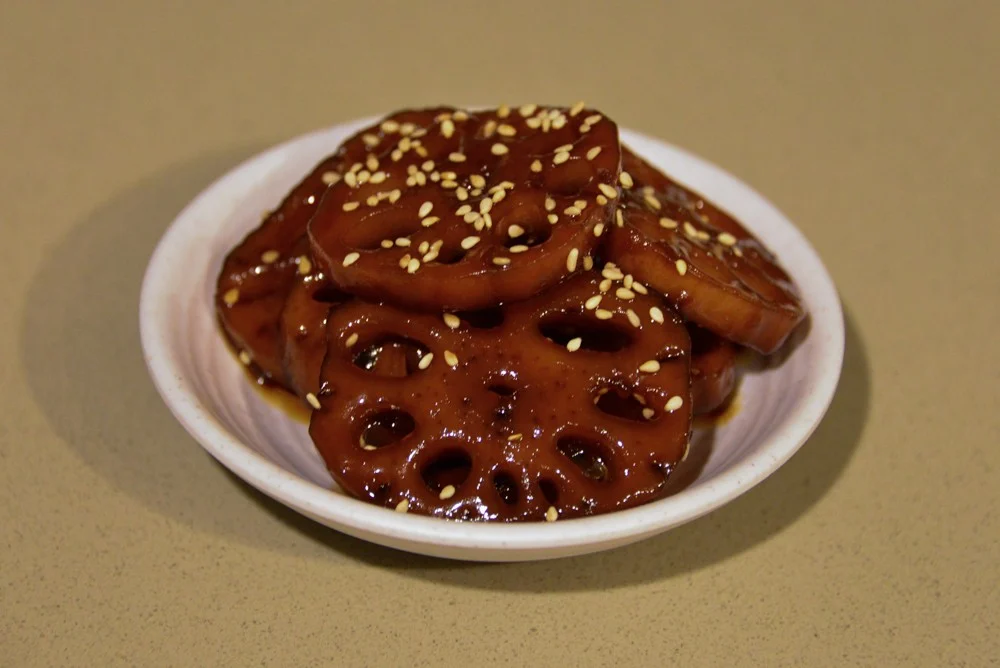Korean Braised Lotus Root Banchan, Yeon
What makes Korean Braised Lotus Root Banchan particularly special is its ability to bridge generations through its universal appeal. The natural sweetness and satisfying chewy texture make it a favorite among children, while adults appreciate its sophisticated balance of flavors and its connection to traditional Korean cuisine. In Korean school lunch boxes (dosirak), this banchan often takes center stage, bringing a touch of home-cooked comfort to the midday meal. The transformation of lotus root from its raw, starchy state to a glazed, tender-yet-chewy delicacy showcases the patience and precision characteristic of Korean cooking techniques.
In modern Korean dining, Korean Braised Lotus Root Banchan continues to hold its place as a beloved banchan, appearing everywhere from home kitchens to premium restaurants. Its popularity has even spread beyond Korea’s borders, introducing international diners to the delightful possibilities of lotus root preparation. The dish’s visual appeal – with each slice showing off the root’s natural geometric patterns – makes it as Instagram-worthy as it is delicious, helping to bridge traditional Korean cuisine with contemporary food culture.
Why You’ll Love This Recipe
- Beautiful presentation with lotus root’s natural patterns
- Perfect balance of sweet and savory
- Satisfying chewy texture
- Make-ahead friendly
- Great for lunch boxes
- Naturally vegan and gluten-free (with gluten-free soy sauce)
What is Yeon-geun-jorim?
Yeon-geun-jorim (연근조림) is a Korean braised lotus root dish where thin slices of lotus root are slowly simmered in a soy sauce-based braising liquid until they develop a glossy coating and chewy texture. The finished dish offers a unique combination of textures and flavors that make it a standout among Korean banchan.

Korean Braised Lotus Root Banchan
Ingredients
- 1 lb lotus roots
- 1 tsp rice vinegar
- 1 tbsp vegetable oil
- 2 cups water
- 1/4 cup soy sauce
- 1 clove garlic minced
- 1/2 cup rice syrup (or sugar)
- 1 tsp sesame oil
- 1 tsp sesame seeds
Instructions
- If using packaged sliced lotus root, skip to step 6.
- Peel, trim and slice lotus roots into 1/4-inch slices.
- Soak sliced lotus roots in cold water for 30 minutes.
- Bring a pot of water to a boil, add vinegar, and blanch lotus root slices for 5 minutes.
- Rinse and drain blanched lotus roots.
- Heat vegetable oil in a heavy-bottomed pot and cook the lotus roots for 10 minutes, stirring frequently.
- Add water, soy sauce, and garlic and bring to a boil.
- Reduce heat to low and simmer covered for one hour.
- Add sugar or syrup and stir to combine. Simmer covered on low for 30 additional minutes.
- Uncover and increase heat to medium-high. Flip around and stir the lotus slices for up to 10 minutes until sticky. Don’t cook to a candy stage, but more like a soft gooey shiny stage.
- Remove from heat and stir in sesame oil and sesame oil to finish.
- Serve as Banchan!
Nutrition
Recipe Tips
- Look for firm, unblemished lotus roots
- Keep sliced lotus roots in water until cooking to prevent discoloration
- Adjust cooking time based on lotus root thickness
- Watch carefully during the final glazing step to prevent burning
- The sauce should coat the lotus root with a glossy sheen without becoming candy-like
Serving Suggestions
Serve with:
- Steamed rice
- Other banchan
- In lunch boxes (dosirak)
- As part of a traditional Korean meal
- Alongside grilled meats or fish
Storage
- Store in an airtight container in the refrigerator for up to 1 week
- The flavor often improves over the first few days
- Can be served cold or at room temperature
Nutrition Information
Per serving (approximate):
- Calories: 90
- Protein: 1g
- Carbohydrates: 18g
- Fiber: 2g
- Sodium: 380mg
Note: Nutrition values are estimates and may vary based on specific ingredients used.
Shopping Tips
- Fresh lotus roots can be found in Asian grocery stores, particularly Korean and Chinese markets
- Pre-sliced packaged lotus roots are a convenient alternative
- Look for lotus roots that are firm and light in color
- Avoid any with soft spots or discoloration
My Essential Korean Pantry contains several of these ingredients, specifically:
– Sempio Soy Sauce
– Marukan Rice Vinegar
– Kadoya Sesame Oil
– Shirakiku Roasted Sesame Seeds


Leave a Reply